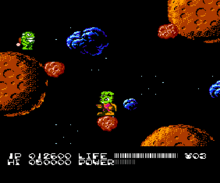Bucky O'Hare (NES video game)
Bucky O'Hare (バッキー オヘア, Bakkī Ohea) is a 1992 action platformer video game for the Nintendo Entertainment System based on the comic book series of the same name. The game was developed and published by Konami, and was released in North America in January 1992, in Japan on January 31, 1992 and in Europe on February 18, 1993.
| Bucky O'Hare | |
|---|---|
 | |
| Developer(s) | Konami |
| Publisher(s) | Konami |
| Director(s) | Masato Maegawa[1] |
| Composer(s) | Tomoko Sumiyama[1] |
| Platform(s) | Nintendo Entertainment System[2] |
| Release | |
| Genre(s) | Action, platformer |
| Mode(s) | Single-player |
The game required Bucky to rescue each of his crew members (except Bruiser, who is not featured in the game) on a series of planets. As each character was rescued, the player gained the ability to switch between them and Bucky on the fly to deal with different problems. Immediately after regaining his entire crew, they are once again captured and imprisoned on the Toad mother ship. Bucky and Blinky, sharing the same cell, break out and must rescue the remaining members. Afterwards, the player continues through the ship.
An arcade game by Konami was also released which allowed players to control Bucky, Jenny, Willy, Deadeye, or Blinky in a format similar to the arcade games based on Teenage Mutant Ninja Turtles or The Simpsons. That version also featured the original voice cast from the TV series.
Gameplay
Bucky O'Hare at its core is very similar to the Mega Man series of games. Initially the player can select from 1 of 4 themed planets (fire, ice, jungle, mechanical) wherein to rescue one of four crew members and use their powers to rescue the others. Their individual abilities are:

- Bucky (a green rabbit) has a straight-shot (like Mega Man) and can also charge up for an extra high jump.
- Blinky (a robot) shoots an arc shot that can break ice and stone blocks and can hover for a short time after charging up.
- Jenny (a cat) has a fast moving attack and can charge a hovering, controllable shot that can attack enemies at a range.
- Deadeye (a duck) has a short range spread shot and when charged can climb walls for a period.
- Willy (a human) has a strong gun that can be charged up to be very strong shot.
Once a character has been unlocked, players can switch between them in real time.
Plot
The Righteous Indignation is attacked in space by the Toads and Bucky's crew; Blinky, Jenny, Dead-Eye and Willy DeWitt scatter to four planets. Bucky journeys to each world, rescuing a crew member who then become a playable character.
Once the crew are reunited they are again attacked in space and captured by the Toads. Bucky journeys through the Toad Mother ship, freeing his imprisoned crewmates before causing the ships main reactor to blow.
While escaping, the player must contend with the Toad Airmarshal before finally fleeing the exploding ship.
The Toads are defeated, but the crew remain vigilant as the fight goes on.
Development
Bucky O'Hare was directed by Masato Maegawa who founded Treasure the same year the game was released.[1] The music in this game was composed by Tomoko Sumiyama (credited as T. Sumiyama). The Escape theme was later included in the Dōjin CD soundtrack Level Up! which was released March 2009 in Japan.
Reception
| Reception | ||||||||
|---|---|---|---|---|---|---|---|---|
| ||||||||
The game received positive reviews from critics, being praised for its side scrolling content as inspired by Mega Man. Fans claimed it was one of the most difficult games on the NES. It was Ranked #2 on the Top 10 Obscure NES Gems by Mike Matei video by Cinemassacre on YouTube, with "Guardian Legend" being #1.[6] Allgame editor Christian Huey praised the "solid gameplay, graphics that are well above par, and a driving soundtrack that ranks among the best for NES action games".[4]
References
- "Bucky O'Hare (1992) NES credits". MobyGames. Blue Flame Labs. Archived from the original on 29 October 2018. Retrieved 28 October 2018.
- "Superheroes Carry On The Fight Fearlessly". Chicago Tribune. January 24, 1992. Archived from the original on June 6, 2012. Retrieved September 24, 2010.
- Bucky O'Hare Release Information for NES, GameFAQs, archived from the original on 2013-04-25, retrieved 2013-09-11
- Huey, Christian. "Bucky O'Hare - Review". AllGame. All Media Network. Archived from the original on November 15, 2014. Retrieved February 23, 2018.
- Famitsu staff (February 7, 1992). "クロスレビュー" [Cross Review]. Famicom Tsūshin (in Japanese). ASCII (164): 38.
- "Top 10 Obscure NES Gems with Mike Matei". YouTube. 2012-05-27. Archived from the original on 2015-10-24. Retrieved 2015-08-01.